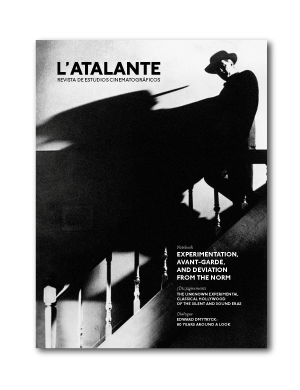Notebook
Rouben Mamoulian: Experimentation, Innovation and the Avant-garde in Hollywood through the Narrative and Expressive Use of Sound
Published 2018-08-29
Keywords
- Rouben Mamoulian,
- Sound Film,
- Avant-Garde in Cinema,
- Sound in Cinema,
- Expressive Use of Sound
How to Cite
Jimeno Aranda, R., & Jiménez de las Heras, J. A. (2018). Rouben Mamoulian: Experimentation, Innovation and the Avant-garde in Hollywood through the Narrative and Expressive Use of Sound. L’Atalante. Journal of Film Studies, (27), 61–74. https://doi.org/10.63700/634
Abstract
This article analyses the work of the Russian-born American filmmaker Rouben Mamoulian, made during the golden era of classical Hollywood cinema, characterised by a unique balance between the aesthetic and narrative conventions of the Hollywood industry and the unique contributions and innovations (the use of sound, colour, editing and format) introduced by the filmmaker into his films. The article focuses particularly on the use of sound for narrative and expressive purposes, and on the poetic and symbolic meaning revealed by these experimentations, with special reference to the director’s first four titles: Applause (1929), City Streets (1931), Dr. Jekyll and Mr. Hyde (1931), and Love Me Tonight (1932).Downloads
Download data is not yet available.
References
Arquero Blanco, I. (2015). De vuelta a la ficción sonora. <em>Espéculo. Revista de Estudios Literarios</em>, <em>54</em>, 155-168. Recuperado de https://webs.ucm.es/info/especulo/Narrar_en_la_era_digital_Especulo_54_UCM_2015.pdf <br>
Bourget, J.-L. (2007). Bella maniera, belle jeunesse. <em>Positif</em>, <em>555</em>, 72-74.<br>
Eisenstein, S., Pudovkin, V., Aleksandrov, G. (1989). Contrapunto orquestal. En J. Romaguera i Ramió y H. Alsina Thevenet (eds.), <em>Textos y manifiestos del cine </em>(pp. 476-479). Madrid: Cátedra.<br>
Gallagher, J. A., Amoruco, M. A. (1982). An Interview with Rouben Mamoulian. <em>The Velvet Light Trap</em>, <em>19</em>, 16-22.<br>
García Fernández, E. C. (coord.). (1982). <em>Historia Universal del Cine</em>, vol. V. Planeta: Madrid.<br>
Goodwin, J. (2001). Eisenstein: Lessons with Hollywood. En A. LaValley y B. P. Scherr (eds.). <em>Eisenstein at 100. A Reconsideration</em> (pp. 91-108). New Jersey: Rutgers University Press. <br>
Higham, C., Greenbug, J. (1969). <em>The Celluloid Muse. Hollywood Directors Speak</em>. Nueva York: The New American Library.<br>
Luhrssen, D. (2013). <em>Mamoulian. Life on Stage and Screen</em>. Lexington: The University Press of Kentucky.<br>
Mamoulian, R. (1986). Quelques problèmes liés à la réalisation de films en couleurs. <em>Positif</em>, <em>307</em>, 53-55.<br>
Robinson, D. (1961). Painting the Leaves Black. An Interview with Rouben Mamoulian. <em>Sight and Sound</em>, <em>30</em>(3), 123-127.<br>
Vila, S. (2001). <em>Rouben Mamoulian. La resistencia como estilo</em>. Valencia: Ediciones de la Filmoteca.<br>
Weinrichter, A. (1993). Un técnico brillante. Rouben Mamoulian. <em>Dirigido por…</em>, <em>216</em>, 52-55.
Bourget, J.-L. (2007). Bella maniera, belle jeunesse. <em>Positif</em>, <em>555</em>, 72-74.<br>
Eisenstein, S., Pudovkin, V., Aleksandrov, G. (1989). Contrapunto orquestal. En J. Romaguera i Ramió y H. Alsina Thevenet (eds.), <em>Textos y manifiestos del cine </em>(pp. 476-479). Madrid: Cátedra.<br>
Gallagher, J. A., Amoruco, M. A. (1982). An Interview with Rouben Mamoulian. <em>The Velvet Light Trap</em>, <em>19</em>, 16-22.<br>
García Fernández, E. C. (coord.). (1982). <em>Historia Universal del Cine</em>, vol. V. Planeta: Madrid.<br>
Goodwin, J. (2001). Eisenstein: Lessons with Hollywood. En A. LaValley y B. P. Scherr (eds.). <em>Eisenstein at 100. A Reconsideration</em> (pp. 91-108). New Jersey: Rutgers University Press. <br>
Higham, C., Greenbug, J. (1969). <em>The Celluloid Muse. Hollywood Directors Speak</em>. Nueva York: The New American Library.<br>
Luhrssen, D. (2013). <em>Mamoulian. Life on Stage and Screen</em>. Lexington: The University Press of Kentucky.<br>
Mamoulian, R. (1986). Quelques problèmes liés à la réalisation de films en couleurs. <em>Positif</em>, <em>307</em>, 53-55.<br>
Robinson, D. (1961). Painting the Leaves Black. An Interview with Rouben Mamoulian. <em>Sight and Sound</em>, <em>30</em>(3), 123-127.<br>
Vila, S. (2001). <em>Rouben Mamoulian. La resistencia como estilo</em>. Valencia: Ediciones de la Filmoteca.<br>
Weinrichter, A. (1993). Un técnico brillante. Rouben Mamoulian. <em>Dirigido por…</em>, <em>216</em>, 52-55.

